Notes: Llanwnda was situated on the Menai Bridge – Afon Wen line which opened in stages between 1852 and 1871. It was on the eastern edge of the settlement from which it took its name. The section of line through Llanwnda was originally part of the Nantlle Railway, a horse-drawn tramway opened in 1827 linking quarries at Nantlle with Caernarfon’s quayside. On 29 July 1862 the Carnarvonshire Railway (CR) was authorised to build a line between Caernarfon and Afon Wen. The CR took over the Nantlle Railway to facilitate the building of its line, but in many places a different alignment was constructed. In October 1866 the largely completed CR was inspected, but its opening was not approved until 2 September 1867 by which time all work was finished.
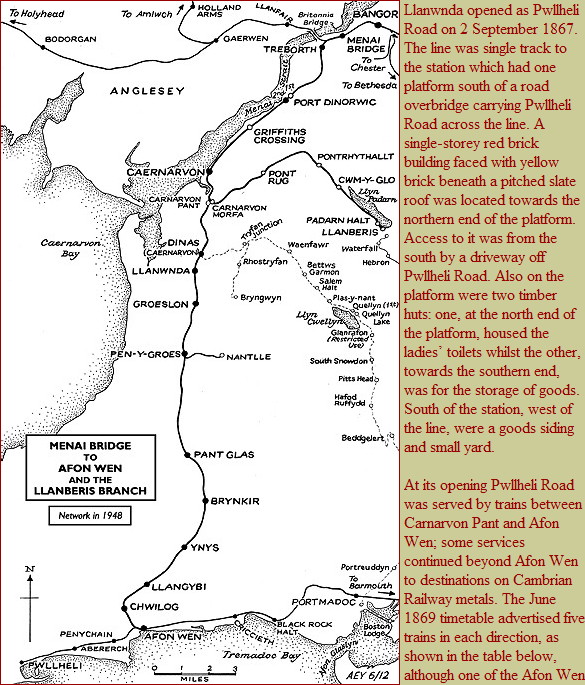 |
trains called at the station on Mondays only. There was one train in each direction on Sundays to Afon Wen at 8.05am which returned en route to Carnarvon Pant at 6.45pm.
Up Trains (Carnarvon Pant direction) June 1869 |
Destination |
Down Trains (Afon Wen direction) June 1869 |
Destination |
7.25am |
Carnarvon Pant |
5.58am Mondays only |
Afon Wen |
12.17pm |
Carnarvon Pant |
10.08am |
Afon Wen |
5.26pm |
Carnarvon Pant |
3.27pm |
Afon Wen |
6.35pm |
Carnarvon Pant |
4.15pm |
Afon Wen |
8.54pm |
Carnarvon Pant |
6.46pm |
Afon Wen |
Following an Act of 4 July 1870 the London & North Western Railway took over the CR. Following the opening of the Carnarvon Town line in July 1869 through passenger services between Bangor and Afon Wen began In January 1871. Pwllheli Road was renamed Llanwnda In September 1877 when a new station called Dinas opened a short distance to the north. A signal box was provided at Dinas which had a passing loop, and its distant signal for trains travelling towards Bangor was actually located at the north end of Llanwnda station’s platform.
By 1895 Llanwnda had six northbound and five southbound Monday-to-Friday trains with extra services on Saturdays, as shown in the table below. There was still only one train in each direction on Sundays.
Up Trains (Menai Bridge direction) December 1895 |
Destination |
Down Trains (Afon Wen direction) December 1895 |
Destination |
8.11am |
Llandudno |
10.04pm |
Afon Wen |
9.17am Saturdays only |
Carnarvon |
12.54pm |
Afon Wen |
11.52am Saturdays only |
Carnarvon |
3.09pm |
Afon Wen |
12.06pm |
Bangor |
4.59pm |
Afon Wen |
2.34pm |
Bangor |
6.59pm Saturdays only |
Nantlle |
5.17pm |
Bangor |
8.15pm |
Afon Wen |
7.46pm |
Bangor |
|
|
9.44pm |
Carnarvon |
|
|
On 1 January 1923 Llanwnda became part of the London Midland & Scottish Railway (LMS). By summer 1928 the LMS was running eight northbound and six southbound trains from Llanwnda on Monday-to-Friday with a couple of extra services on Saturdays. There were no Sunday trains. The frequency remained the same in April 1932.
On 1 January 1948 Llanwnda became part of British Railways (London Midland Region). In summer 1948 there were only six northbound and seven southbound Monday-to-Friday trains with an additional northbound on Saturdays. No Sunday trains ran.
From summer 1947 and throughout the 1950s the line |
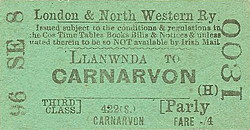 |
through Llanwnda was very busy as many specials were run to the Butlin’s holiday camp which opened for business that year. Most of these trains, however, did not stop at Llanwnda. In the winter months the line was quiet with Llanwnda having only seven trains in each direction, as shown in the table below.
Up Trains (Menai Bridge direction) 17 Sept 1956 – 16 June 1957 |
Destination |
Down Trains (Afon Wen direction) 17 Sept 1956 – 16 June 1957 |
Destination |
7.13am |
Manchester Exchange |
9.37am |
Afon Wen |
8.44am |
Bangor |
12.06pm |
Pwllheli |
11.31am |
Bangor |
12.52pm |
Pwllheli |
2.47pm |
Bangor |
3.28pm |
Pwllheli |
4.34pm |
Llandudno Junction |
4.41pm |
Afon Wen |
6.05pm |
Bangor |
6.13pm |
Pwllheli |
7.50pm |
Llandudno Junction |
7.43pm |
Afon Wen |
The goods siding could be served only by southbound trains. They had to stop south of the points that gave access to the siding and reverse wagons in. In the 1950s the goods siding was used exclusively by a local coal merchant. Although five wagons could be accommodated, only one was generally required. It arrived on a Monday, was emptied, and worked away the same day. On one occasion in the 1950s two wagons were delivered to Llanwnda, much to the surprise of the coal merchant and the station staff. When the labels were examined it was discovered that one should have gone to Llanwrda on the Central Wales line. The label was promptly lost, and the coal merchant made a healthy profit which was shared with the railway staff.
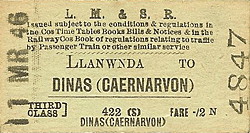 |
By the late 1950s few passengers used the station. Until the mid 1950s newspapers were delivered on the early morning train, but otherwise it was a quiet place. It was little wonder then that in the Reshaping of British Railways in 1963 (The ‘Beeching Report’) Llanwnda was recommended for complete closure with the line between Caernarfon and Afon Wen; this took place on |
on 7 December 1964.
The Caernarfon - Afon Wen line was not lifted immediately. However no trains travelled along the remaining section of track from Caernarfon to Llanwnda until June 1969. During that month engineers’ specials were run to test the track in advance of the Investiture of Prince Charles as Prince of Wales at Caernarfon Castle on 1 July 1969. Many specials were run for the event and needed to be accommodated during the ceremony before their return journeys. They were positioned nose-to-tail from Llanwnda back towards Caernarfon. The first to arrive at Caernarfon deposited its passengers and ran forward to Llanwnda. On arrival its locomotive was detached and drew forward to the furthest extent of the line. The next train then pulled up behind the first. Its locomotive detached and attached itself to what had been the rear of the first train. That train was then ready to make a return journey. The process was repeated all the way down the line leaving all the specials facing in the right direction to return to Caernarfon. When they had all departed an engine was left at Llanwnda to run light to Caernarfon.
Shortly after the Investiture the track was lifted back to Caernarfon.
The station building and platform were demolished in the 1970s and in 2000 much of the station site was lost when the junction between the Pwllheli and Porthmadog roads was remodelled.
Tickets from Michael Stewart route map drawn by Alan Young
Sources:
- Bangor to Portmadoc including the Llanberis lines – V Mitchell & K Smith – Middlewood Press 2010
- Bradshaws Rail Times December 1895 - Middlewood Press 2011
- Bradshaws Rail Times July 1922 - Guild Publishing 1986
- British Railways (London Midland Region) Timetable 23rd May to 25th Sept 1949
- British Railways (London Midland Region) Timetable 17th of Sept 1956 to 16th of June 1957
- British Railways (London Midland Region) Timetable 18th of June 1962 to 9th of September 1962
- From Chester to Holyhead: The Branch Lines – B Rear - OPC 2003
- LMS Time Table July 18th to September 11th 1932
- Railway Passenger Stations in Great Britain a Chronology - M Quick - Railway and Canal Historical Society 2009
To see the other
stations on the Menai Bridge - Afonwen line click on the station
name: Menai Bridge, Treborth, Port Dinorwic (1st), Port Dinorwic (2nd), Griffiths Crossing, Caernarvon, Carnarvon Pant, Dinas , Groeslon, Penygroes, Pant Glass, Brynkir, Ynys, Llangybi, Chwilog & Afon Wen
See also: Nantlle |

old3.jpg)
.jpg)
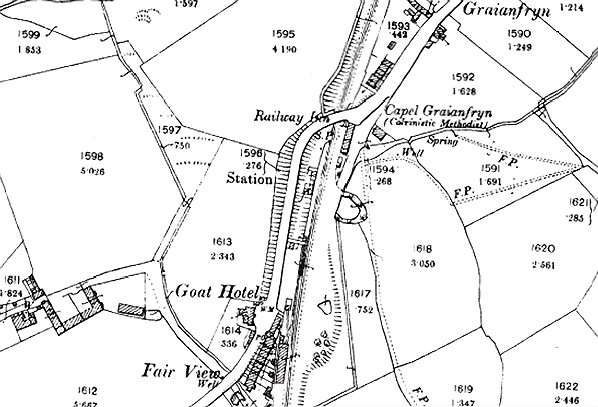
old1.jpg)
old4.jpg)
old6.jpg)
old2.jpg)
5.jpg)
8.jpg)
1.jpg)



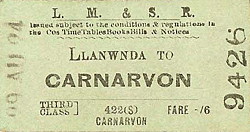
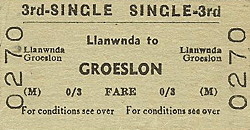
old5.jpg)
old7.jpg)
.jpg)
2.jpg)
3.jpg)
4.jpg)
7.jpg)
6.jpg)
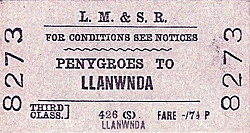

 Home Page
Home Page